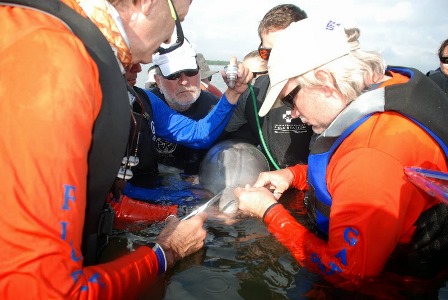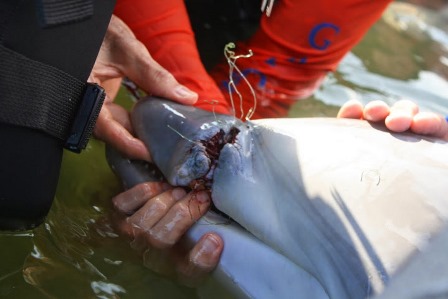UF aquatic animal health team assists in dolphin disentanglement

Dr. Mike Walsh and Dr. Craig Pelton, in the orange shirts, are shown with a male dolphin calf off the coast of Fort Pierce on March 6. They are working to remove monofilament fishing line from the calf’s upper jaw. The calf is being given oxygen while being supported by other members of the disentanglement team. (Photo courtesy of Hubbs-Sea World Research Institute.)
Veterinarians and biologists with the University of Florida’s Aquatic Animal Health Program were involved in a two-day multi-agency effort to rescue and treat a dolphin calf with a monofilament fishing line deeply embedded around its upper jaw.
The entangled male calf was originally reported on Jan. 18 by a member of the public. An evaluation protocol that included UF veterinarians, National Oceanic and Atmospheric Association staff, and veterinarians from SeaWorld and Mote Marine determined that the calf’s injuries were life threatening. The NOAA then authorized and coordinated the efforts to rescue and treat the animal.
Dr. Craig Pelton, Dr. Mike Walsh, AAH program intern Dr. Bryan Vorbach and biologist Rachael Dailey, all from UF, worked with Dr. David Kilpatrick of Harbor Branch Oceanographic Institute to remove the entanglement from the dolphin’s jaw.
The NOAA and the National Marine Fisheries Service coordinated a large collection of personnel and boats to assist. Among the many groups represented were the Florida Fish and Wildlife Conservation Commission, Clearwater Marine Aquarium, SeaWorld, Hubbs-Sea World Research Institute, Dolphins Plus and Georgia Aquarium Conservation Field Station. All had a part in capturing and disentangling the young calf.
The calf and its mother were surrounded by a large net and restrained by experienced dolphin personnel. Their breathing and heart rates were monitored consistently and supplemental oxygen was administered to the calf during the procedure.
“The monofilament line was successfully removed and the calf treated with a long-acting antibiotic,” Walsh said. “The injury from the line was down to the level of the bone and may have been interfering with nursing and eating, since the calf was underweight for its age.”

This close-up photo shows the extent to which the monofilament fishing line was embedded in the young dolphin’s jaw. The line wa subsequently removed and the wound cleaned. (Photo courtesy of Hubbs-Sea World Research Institute)
A tracking device was placed on the mothers dorsal fin to monitor the pair over the next few months.
“Their release after the procedure was very smooth and the pair returned to the water, where Harbor Branch personnel experienced in wild dolphin observations will check on the baby regularly to monitor the healing process,” Walsh said. “All the participants in the event were very pleased with the procedure and the outcome.”










